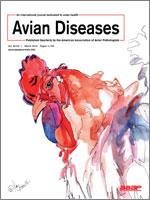Between April 2013 and April 2015, seven flocks belonging to three different major commercial egg producers inCalifornia experienced a mild increase in mortality 2 to 3 wk after administration of Salmonella Enteritidis bacterins. Strains of chickens involved were H&N (flock A1, A2, B2, C1, C2, and C3) and Lohmann white (flock B1). Vaccination was administered individually through injection either in the breast muscles or subcutis in the legs between 11 and 18 wk of age in all flocks. Clinical signs ranged from inapparent to lameness, reluctance to walk, greenish diarrhea, and retching-like symptoms. The mortality ranged from 0.16% to 1.38% per week, with the highest peaks occurring usually 2 to 3 wk postvaccination, and then declined rapidly. Postmortem examinations revealed enlarged livers with disseminated hemorrhages and pale foci of necrosis. Also, severe extensive hemorrhages in the intestine, heart, and proventriculus were observed in a few birds. Various degrees of productive, exudative giant cell granulomatous myositis were observed invading deeply the muscles and subcutis at the site of vaccination. The myositis was always associated with optically empty vacuoles positive for neutral lipids by Oil Red O stain. Droplets of Oil Red O material were also noticed in the affected livers and intestines. Congo red stain highlighted the presence of amyloid in moderate to severe amounts in the breast muscles and moderate amounts in livers, spleens, and intestines. Salmonella antigens were detected in the injection sites and livers by immunohistochemical staining. No viruses or toxic substances were recovered from the liver, spleen, intestine, and pectoral muscles, and the few bacteria isolated were interpreted as secondary postmortem invaders. In addition, livers and bile tested for hepatitis E virus were negative by reverse-transcriptase polymerase chain reaction.
How to translate text using browser tools
14 November 2015
Characterization of Seven Outbreaks of Hemorrhagic Hepatopathy Syndrome in Commercial Pullets Following the Administration of a Salmonella Enteritidis Bacterin in California
S. Carnaccini,
H. L. Shivaprasad,
G. Cutler,
M. Bland,
X. J. Meng,
S. P. Kenney,
A. A. Bickford,
G. Cooper,
B. Charlton,
C. G. Sentíes-Cué
ACCESS THE FULL ARTICLE

Avian Diseases
Vol. 60 • No. 1
March 2016
Vol. 60 • No. 1
March 2016
amyloidosis
bacterin
chicken
hemorrhagic hepatopathy
pullet
Salmonella enteritidis
vaccine




